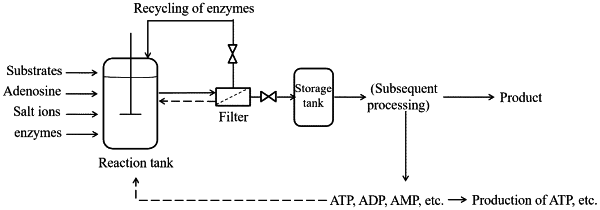| CPC C12P 19/40 (2013.01) [C12N 9/1229 (2013.01); C12N 9/16 (2013.01); C12N 15/70 (2013.01); C12Y 207/04001 (2013.01); C12Y 207/04003 (2013.01); C12Y 301/03004 (2013.01)] | 4 Claims |

|
1. A method of producing a product from an enzymatic reaction requiring adenosine triphosphate (ATP), the method comprising the following steps:
(1) adding ATP regeneration enzymes, AK (adenosine kinase) enzyme, enzyme that produces the product, and adenosine to an enzymatic reaction system to carry out the enzymatic reaction, wherein:
the ATP generation enzymes are a combination of two or three enzymes selected from the group consisting of: polyphosphate kinase (PPK), adenylate kinase (ADK), and polyphosphate: AMP phosphotransferase (PAP);
adenosine is used instead of ATP and adenosine monophosphate (AMP);
the product is creatine phosphate;
the enzyme that the produces the product is a transferase for transferring a phosphate group and is creatine kinase;
the enzymatic reaction requiring ATP is a synthesis reaction of creatine phosphate; and
the enzymatic reaction system is a 100 L enzymatic reaction system that comprises:
a solution comprising:
2.0 kg of creatine;
0.2 kg of adenosine;
1.8 kg of sodium polyphosphate;
0.4 kg of potassium chloride;
0.5 kg of magnesium chloride hexahydrate; and
0.3 kg of disodium hydrogen phosphate, wherein the pH of the solution is adjusted to 7.0;
ATP regeneration enzymes comprising PPK enzyme 500 U/L and ADK enzyme 500 U/L;
AK enzyme 500 U/L; and
creatine kinase 1000 U/L;
wherein the enzymatic reaction system is maintained at a temperature of 35° C. and a pH of 7.0;
(2) separating the ATP regeneration enzymes, the AK enzyme, and the creatine kinase from the enzymatic reaction system after five hours of reacting the solution, the ATP regeneration enzymes, the AK enzyme, and the creatine kinase to produce a filtrate comprising creatine phosphate, ATP, ADP, and AMP, wherein:
the ATP regeneration enzymes, the AK enzyme, and the creatine kinase are separated from the enzymatic reaction system with an ultrafiltration membrane in a filter;
enzyme activity of the separated ATP regeneration enzymes, the AK enzyme, and the creatine kinase are reduced by 5%-20% compared with that before enzymatic reaction; and
the separated ATP regeneration enzymes, the AK enzyme, and the creatine kinase are recycled for use in step (1) for the enzymatic reaction; and
(3) separating and purifying the filtrate of step (2) to obtain the creatine phosphate.
|